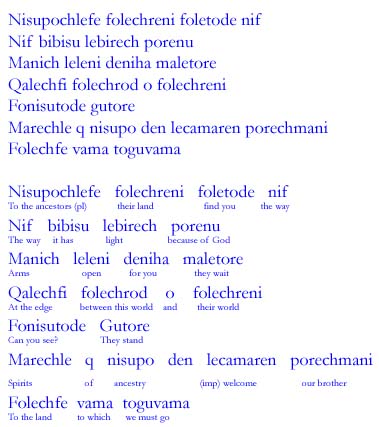Thaduracian
Suprisingly, a fair bit is known about early Thaduracian (210BC-300AD) pronunciation and grammar. This was aided by the discovery of documents (thought to be that of Thadurac himself), detailing various points on word markings, inflections and indeed some on pronunciation.
Initial studies showed that early Thaduracian was quite synthetic. Verbs were highly inflected to denote things such as: person, modality, mood, voice (always the indicative as there was no passive), and tense. Pronouns were rarely used with the verb, possibly only for emphasis.
Thaduracian was a syllabic language. That is, consonants had an inherent vowel (though these vowels differed from consonant to consonant, unlike most abugidas where the inherent vowel was the same for all). These 'inherent vowel sounds' remained static in base words and roots, but could be changed in affixes by diacritical markings. Vowel sounds could also be silenced, again with a specific marker. The alphabet consisted of 17 consonants (however the sounds ch and th had no inherent vowel), and was as follows (inherent vowels included with the nearest English sound representation):
bi-as in bit /bɪ/
po-as in pot /pɒ/
de-as in street /di:/
to-as in boat /bəʊ/
c/k/qa-as in father /ka:/
gu-as in but /gʊ/
fo-as in caught /fɔ:/
va-as in bait /veɪ/
su-as in soon /su/
zi-as in like /zaɪ/
le-as in bet /le/
ma-as in father /ma:/
ni-as in bit /nɪ/
re-as in street /ɹi:/
hu-as in root /hu/
th-
ch-
As we know, King Thadurac was a Carthaginian and would have spoke Punic, a neo-Phonecien language, and would have written in a Phonecian variant. When he created Thaduracian, he chose to write it using his own varient of the Etruscan alphabet. He created glyphs with a one to one morphemic identity, assigned stand alone values to each character, and also marked some characters with diacritics, also giving them stand alone values (mainly to denote prepositions and conjunctions). Since the Etruscan alphabet did not distinguish voiced and unvoiced occlusives, b, d and g, he created varients of other glyphs to denote these as they had to be distinguished in Thaduracian (due to the vowel inherency).
Below is a transliteration of a Thaduracian pagan 'Prayer For The Dying', as it would have looked written in the Latin alphabet (is not phonetic, see above for pronunciation; original script to follow shortly):
Find your way to the land of the ancestors,
for the way is lit from the light of God.
They wait for you with open arms,
there on the edge, between this world and the next.
See; they stand.
Ancestral spirits, welcome our brother to the place we all must go.
Although there were many prayers and ritual writings in Thadurac's new language, it lacked standardization. It wasn't until the transition into proto-Dalcurian that a standard written form was established. This became evident after studying later versions of the same [above] prayer in which variations of verb stems and grammar can be seen.
Other Thaduracian traits :
- Adjectives and nouns with a verbal relative were formed with derivational affixes.
- It was highly morphemic; for example, free adjectives (non verb-related) were formed with bound morphemes to denote opposition, eg: ged-big, stiged-small, belu-cold, stibelu-warm.
- It only had one past tense: preterite and perfect were rendered as the same, although telecity could be accounted for with a marker.
- There was no copula 'to be', a feature that still exists in the language today.
- Syncopation towards the end of the Thaduracian period.
An interesting feature of Thaduracian through to modern Dalcurian is that, the language has never undergone typical 'vowel shifts' that many languages suffer. Vowel sounds of today more or less emulate those of Thaduracian and it's successors.
